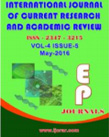Abstract Volume:4 Issue-5 Year-2016 Original Research Articles
 |
Online ISSN : 2347 - 3215 Issues : 12 per year Publisher : Excellent Publishers Email : editorijcret@gmail.com |
2Dept. of Biotechnology, Jairam Arts & Science College, Salem-08, India
3Department of Microbiology, IRT Medical College, Perundurai, Erode, India
The incidence of fungal infections has been increasingly reported in the recent years. This is mainly due to the advent of newer antifungal agents, increased use of immunosuppressive drugs, climatic factors and poor hygienic conditions. Dermatophyte refers to the infection caused by a group of fungi namely Trichophyton, Epidermophyton, and Microsporum. Topical and systemic therapies are commonly used in the treatment of these infections .However due to the indiscriminate usage of antifungal agents has resulted in the development of drug resistant strains. Ethanomedical plants have been used traditionally since ancient times in the treatment of these infections. In this study the phytochemical and the antidermatophytic activity of Aristolochia bracteata has been studied. The plant powder was purchased from the local Siddha medical shop was extracted with two different solvent systems and subjected to Preliminary phytochemical screening. The leaf extracts were subjected to TLC, HPTLC, MS and NMR spectra. The antidermatophytic activity of the plant extract was determined by disc diffusion method. The photochemical analysis of the plant showed phenols, flavanoids, saponin and alkaloids class of compounds. The methanol solvent was found to be the effective extraction of the bioactive fractions of the leaf. The HPTLC fractions of the leaf extracts showed Acetylenic acid derivatives. The structural identification of acetynelic acid analog was readily achieved by H1 NMR spectra and the molecular formula of the acetynelic acid was C16H28O2 was predicted. The methanol extract exhibited higher activity at 2gm/disc concentration when compared to the other concentration tested by disc diffusion method. The results of the study suggest that the antidermatophytic activity of Aristolochia bracteata could be attributed to the presence of acetylenic acid in the leaf fractions contributing to the antidermatophtic activity. However further studies are still required to know the exact concentration at which these fractions are effective for the development of herbal preparation that will be useful in the treatment of dermatophytic infections in the future.
How to cite this article:
Yuvasri, B., K.C.P. Rajamanikandan, P. Madumathi, P.M. Ayyasamy and Arvind Prasanth, D. 2016. Preliminary Phytochemical Screening and Antidermatophytic activity of Aristolochia bracteata. L.Int.J.Curr.Res.Aca.Rev. 4(5): 21-26doi: http://dx.doi.org/10.20546/ijcrar.2016.405.003



Quick Navigation
- Print Article
- Full Text PDF
- How to Cite this Article
- on Google
- on Google Scholor
- Citation Alert By Google Scholar
